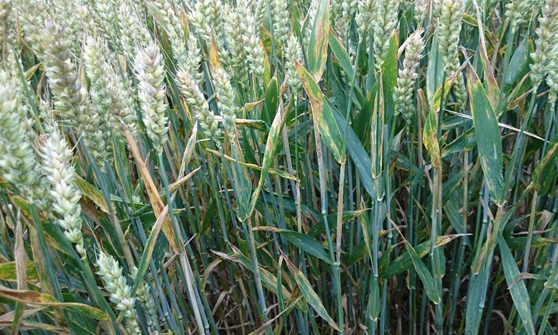Winter Wheat Disease Update – June 2020
7 June 2020The table below shows the growth and disease observations in SRUC’s monitored crops. This data is generated in commercial crops in your area so is indicative of the disease pressure and growth stages on farms at the moment.
| Winter Wheat | Average | Maximum | Minimum |
|---|---|---|---|
| Crop Growth Stage | 46.7 | 59 | 37 |
| Mildew | 3.8 | 10 | 0 |
| Septoria tritici | 0.5 | 2 | 0 |
| Stem disease | 3 | 5 | 0 |
Disease risks
The shift to wetter weather over flowering obviously ups the risk of ear diseases and increases the chance that septoria levels which have been relatively low until now could flare-up. The fact that most flag leaf sprays were well-timed and used SDHI and azole chemistry is a plus, and the ear spray will give some continued protection. Yellow rust levels have fallen now that most crops are covered by fungicide programmes and mildew has only been picked up in a few crops.
The best timing for ear sprays in terms of ear diseases is flowering as this is a peak risk period for fusarium and microdochium infection, where the disease is aided by a rainfall event. If it is wet early in flowering that means an infection event is very likely and then the best timing for an ear spray is also early flowering as the efficacy of fungicides drops sharply once you move outside a 48-hour window from that infection starting. If it is dry over flowering there is more scope to delay the head spray to later in flowering. Once you move beyond flowering and into grain filling then the yield response to an ear spray starts to fall away. The backbone of ear sprays remain azole fungicides.
It is essential that mycotoxin risk assessments are carried out for all wheat entering the food chain. AHDB’s Risk Assessment for Fusarium Mycotoxins in Wheat is available using the link. This should be started before flowering so that you can include the risk in your T3 fungicide plans (a nice example of IPM practice).
It captures the main drivers of fusarium risk which are wet weather at flowering and then wet weather over grain filling and ripening. A record should then be kept of rainfall at flowering and over-ripening as this is the main driver of risk and accounts for almost 60% of the maximum risk score that would be possible. We are at inherently lower risk in Scotland because many of the mycotoxin forming Fusarium species like warm temperatures, but many do occur widely in Scotland so we shouldn’t be complacent. Trash is another risk factor so direct drilled crops are at slightly greater risk.
When making decisions about ear sprays, check latest application dates carefully and also any other restrictions that apply when the programme for the crop is considered – such as the two application limit for strobilurins, SDHIs and for specific products; check with your local agricultural consultant or agronomist for site-specific advice.
Sign up to the FAS newsletter
Receive updates on news, events and publications from Scotland’s Farm Advisory Service

